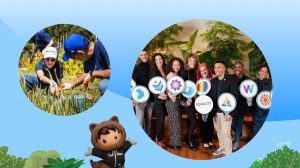Earth Month presents a powerful opportunity to reflect on the role that business can play in achieving sustainability and combating climate change.
At Salesforce, sustainability is more than a core value, it’s a driving force. In 2021, the company achieved net zero residual emissions across its full value chain and 100% renewable energy for its operations. This week, it introduced a series of new initiatives designed to foster a more sustainable and equitable future through the use of AI.
During her trip to Sydney, Suzanne DiBianca, EVP and Chief Impact Officer at Salesforce, discussed how businesses can integrate sustainability into their everyday operations.
Q. During your visit, did any local businesses stand out as leading the way on sustainability in Australia?
My visit to Australia was a fantastic opportunity to connect with local companies. Sustainability isn’t just good for the planet, it’s good for business. Schneider Electric’s Sustainability Index, 2023 revealed that more than three-quarters of Australian companies believe sustainable transformation is driving a competitive edge, and over two-thirds agree that Australia must meet net zero emissions targets to remain economically competitive.
In Australia, I saw the growing focus on sustainability and environmental responsibility as a business imperative. Companies like Endeavour Energy, which uses Salesforce’s Net Zero Cloud to power its carbon emissions accounting platform, are setting a leading example of the role businesses can play toward a more sustainable future.
Q. How can Australian businesses leverage technologies like AI to set and achieve sustainability targets?
Australian businesses can leverage AI to get smarter on sustainability goals and achieve them quicker, and make reporting easier as they navigate a rapidly evolving regulatory landscape.
AI can be used to analyse data to pinpoint areas for improvement, like energy use and waste and predict future environmental impact. Imagine farms using AI for smarter irrigation or logistics companies optimising delivery routes – all leading to a reduced carbon footprint.
But we know that the increased use of AI across organisations won’t be without an environmental impact, so responsible development is crucial. As AI use increases, data centre energy demands are expected to triple by 2030. Businesses can be part of the solution by powering their operations and data centres with renewable energy and advocating for more transparency in AI’s climate impact
Salesforce is a prime example: we develop smaller, energy-efficient AI models, leverage the most efficient hardware available, and prioritise low-carbon data centres to train our models.
Q. How does Salesforce respond to sustainability challenges tied to AI?
There are three main sustainability challenges that we are looking to address. While I’ve already touched on some of these challenges earlier, this doesn’t make them any less important.
- The energy demands of AI: We know that the load on data centres is expected to triple by 2030, and given these projections, we must make AI more sustainable for all users.
- Emissions from the supply chain: Supply chain emissions are another challenge that must be addressed across all businesses. We’ve seen that for most companies, most emissions come from their value chains (Scope 3). To help tackle this, we’ve launched the Salesforce Sustainability Exhibit, which asks suppliers to set science-based targets, increase sustainability disclosures, and deliver carbon-neutral products and services to Salesforce.
- Greater access to data: We need to get faster and better at tracking our climate impact. At Salesforce, with Net Zero Cloud we’ve been able to streamline our reporting process internally and for our customers. Having greater access to data will play a critical role in unlocking these and bringing them together, especially in the corporate environmental, social, and governance (ESG) world with data living across disparate systems.
Q. Any final tips for Australian businesses on their sustainability journey?
Every business is different, but one thing is certain: we all must look toward a more sustainable future. We can’t do this alone, and we must collaborate globally with customers, suppliers, peers, governments, and all other stakeholders on the journey.
If they haven’t done so yet, all companies should focus on creating a climate transition plan. If crafted effectively, it can be a north star to stay on the right path for sustainability. We have to reduce emissions, but we also have to invest in ecosystem conservation and restoration. This is why Salesforce launched our Nature Positive Strategy last year. We’re also a founding member of 1t.org, the global movement to conserve, restore, and grow healthy forest ecosystems by 2030.
Sustainability isn’t a destination. It’s a continuous journey. Start by taking those first steps, set ambitious goals, and don’t be afraid to collaborate with others. Together, Australian businesses can play a key role in the fight against climate change.














